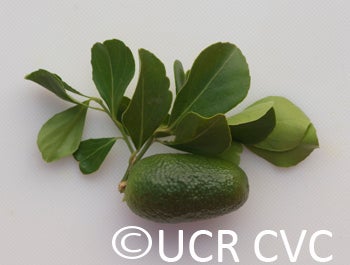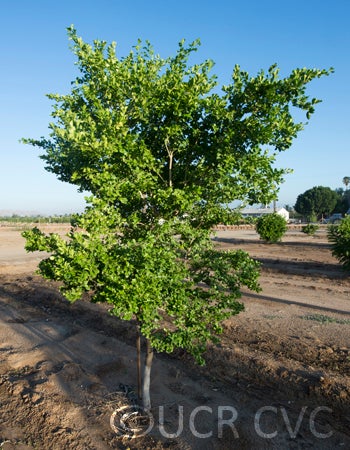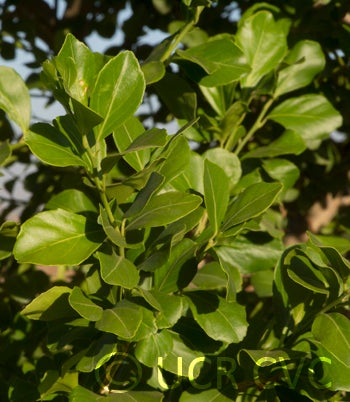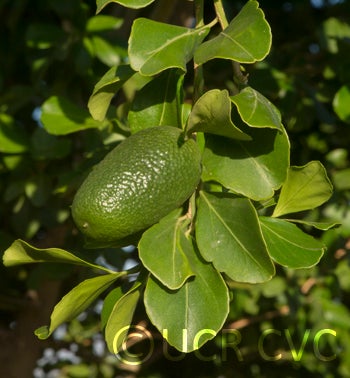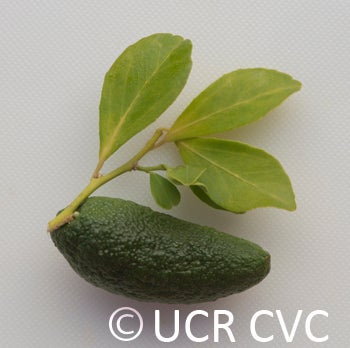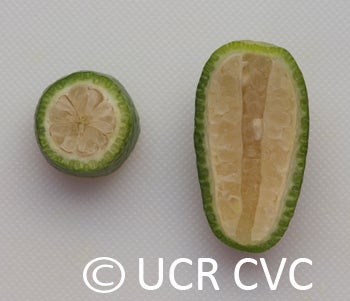Garroway's Australian wild lime
RSD 2002022
Source
Received as seed from M. Smith, Queensland DPIF Bundaberg Research Station, Queensland, Australis, 2002.
Parentage/origins
Parent unknown. Open pollinated seedling.
Rootstocks of accession
Own root.
Season of ripeness at Riverside
Year round.
Season of flowering at Riverside
February to April
Notes and observations
One of five seed lots of M. garrowayae (RSD 2002021, RSD 2002022, RSD 2002023, RSD 2002024, RSD 2002025) introduced from trees growing on the Bundeberg Station. See citations for more information on this accession. (RR Krueger, 01/11/2010)
Description from The Citrus Industry Vol. 1 (1967)
"Bark with minute, irregularly interrupted longitudinal ridges; young twigs very slender, 0.8-1.5 mm diam., cylindric or rarely slightly angled when very young, with very small more or less upward curving, hyaline hairs; internodes 4-15 mm long (usually about 6-10 mm), with very slender spines, 2-5 mm long, or spineless; older twigs below last growth show gray, corky, longitudinal, more or less confluent streaks, 0.5-1 mm wide, that show fissures (these corky streaks become more and more abundant and finally run together, so that two-year-old twigs show little or no green bark); leaves of cotype specimen (from Mount White, Queensland) narrow, thick and leathery, lozenge-shaped to broadly lanceolate, 30-45 X 15-20 mm (small leaves 20-25 X 10-12 mm), bluntly pointed, rounded or even slightly emarginate at apex, cuneate at base, with 5-7 pairs of veins, visible on both surfaces of the leaves, arising at the midrib and occasionally branching, margins nearly entire, slightly undulate; leaves on leading twigs of greenhouse specimen 20-25 X 12-18 mm, lozenge-shaped or broadly ovate, bluntly rounded or slightly emarginate at apex, cuneate at base, margins slightly dentate or crenulate especially toward the apex, with a few hyaline hairs on the margin at the base of the leaf and still fewer on the lower portion of the midrib; petioles 2-4 X 0.8-1 mm, wingless, flattened above, articulated with the blade, finely pubescent on the upper flattened side, especially at the edges; fruit of cotype specimen ellipsoid or cylindric-ellipsoid, 4 X 2 cm, with numerous sunken oil glands.
Bailey described this species as follows, under the name of Citrus garrowayi: "Fruit upon the slender branchlets oblong, 2 1/2 in. long, 14 lines diameter. Oil glands large, giving a tuberculose appearance to the fruits; ultimately these glands sink, and the fruit appears then to be lacunose; rind very thin; cells 4 or 5; pulp of a sharp agreeable acid; seeds 3-angular, white, free, with more or less very short hairs, about 3 lines long and 2 lines thick in the centre. The rough rind of the fruit somewhat resembles that of C. australis, but the form of fruit is nearer to that of C. australasica; the fruit of this latter, however, is nearly smooth and the glands small."
Microcitrus garrowayi seems to be a good species, distinct from M. australasica and M. australis, occurring farther to the south in eastern Australia. Bailey called this the Mount White lime. It has been introduced into the United States."
Availability
Not commercially available in California.
USDA Germplasm Resources Information Network page for Microcitrus garrawayae (RSD 2002022)
